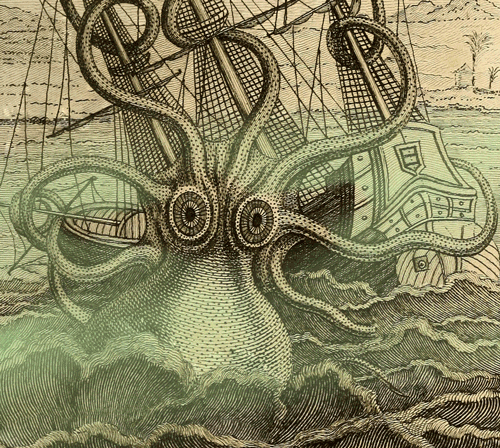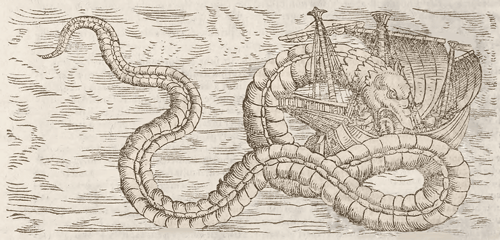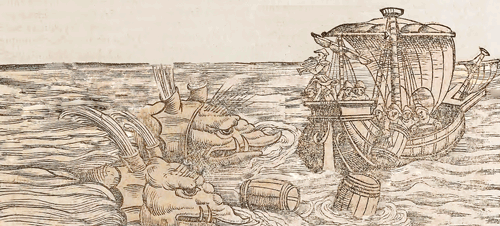Five “Real” Sea Monsters Brought to Life by Early Naturalists
From kraken to mermaids, some monsters are real—if you know how to look for them
/https://tf-cmsv2-smithsonianmag-media.s3.amazonaws.com/filer/d6/34/d634b349-4a5c-45e3-be69-70936300b129/sea-devil.jpg)
“HIC SUNT DRACONES.”
This phrase translates from the Latin as “here are dragons.” It is etched on the eastern coast of Asia on one of the oldest terrestrial globe maps, the Lenox Globe, dating to 1510. Though the phrase itself is found on only one other historical artifact—a 1504 globe crafted on an ostrich egg—depictions of monsters and mythological beasts are common on early maps. They mostly crop up in unexplored reaches of the oceans, warning would-be explorers of the perils of these unknown territories.
One of the most famous of these maps is Olaus Magnus’ Carta Marina, drawn between 1527and 1539. Magnus (1490-1557) was the Catholic archbishop of Sweden and a prominent historian. His travels brought him farther north than any of his contemporary European intellectuals, lending a great deal of perceived credibility to his accounts and publications. Carta Marina is a detailed map of Scandinavia—one of the oldest ever created—and it depicts the Norwegian Sea so teaming with monsters that it would seem impossible to escape these waters uneaten. In 1555, Magnus published Historia de Gentibus Septentrionalibus (“A Description of the Northern Peoples”), which not only related the history, customs, and beliefs of the Scandinavian people, but also reprinted and described the creatures found on Carta Marina. His standing and reputation secured the widespread acceptance of his stories.

Magnus’ descriptions and drawings were copied repeatedly, with little to no modification, for centuries by such historical titans as Edward Topsell, Ulisse Aldrovandi, John Jonstonus and Conrad Gessner, whose Historia Animalium, replete with Magnus’ drawings, is the first modern zoological work attempting to describe all known animals. Such repurposing ensured that these creatures were ingrained in the public mind as truth. And over the centuries, many new monsters were added to the mix.
Where did the accounts of monsters come from in the first place? Were they simply fairy tales invented to scare curious minds and small children? Henry Lee, who wrote extensively on sea creatures and monsters, emphasized that many classical monsters are not simply pure myth. In his publication Sea Fables Explained (1883), he wrote, “… the descriptions by ancient writers of so-called ‘fabulous creatures’ are rather distorted portraits than invented falsehoods, and there is hardly any of the monsters of old which has not its prototype in Nature at the present day.”
These “distorted portraits” came about in part because by the 1500s extensive oceanic exploration was still limited, and the fauna that called these places home remained virtually unknown. Publications by Magnus and those who copied him represented some of the first attempts to systematically aggregate and describe these animals. More often than not, their information came not from first-hand observations but from sailors’ accounts of mysterious encounters while at sea. Less often, the decomposing remains of a washed-up carcass fueled confidence in the existence of these terrible beasts.

Sailors, or beachgoers who had the misfortune to stumble upon a rotting basking shark, had no experience with such creatures. So they explained them with what they knew well: myths and legends. If they enlivened their accounts, that simply made for a better story. And so an oarfish became a 200-foot-long sea serpent. A giant squid became a blood-thirsty kraken. A manatee became a mermaid. Magnus and others like him gobbled up the stories and published them alongside authentic species. The more the stories were circulated and published, the more likely people were to mistake what they did see for a monster. And the cycle continued.
The atmosphere of the day also fed people’s willingness to believe such tales. The 1500s were rampant with superstition. The Scientific Revolution would not start to make headway until later in the 17th century. There was no division between magic and reality—the two simply coexisted, so there was no reason to doubt mythical beasts. And even when scientists began to embrace the scientific method, they still struggled to reconcile previous beliefs in the supernatural with science. It would take hundreds of years of dedicated scientific study and exploration to overturn classical and common opinion. In the case of some creatures (i.e., sea serpents), sightings and questions of authenticity still remain.
Today we know that the animals that inspired such hair-raising tales as the sea serpent, leviathans and hydra and authenticated stories of mermaids and the kraken are real. They just received some creative embellishments (and sometimes blatant artistic fraudulence) along the way. And in a world just beginning to turn away from superstition, but still inclined to embrace elements of mysticism, it’s not surprising that the tales were accepted. Besides, who doesn’t love a good monster story?

Follow the Biodiversity Heritage Library blog and #bhlMonstersRreal on Twitter all week to get the scoop on the people, books and animals that inspired some of history’s most legendary monsters—including the full stories behind these five incredible beasts:
Release the Kraken
/https://tf-cmsv2-smithsonianmag-media.s3.amazonaws.com/filer/a0/67/a06702dd-749d-476a-b2bb-dfa76335ca89/kraken2.jpg)
Aristotle introduced the world to the giant squid (which he called teuthos) in 350 B.C. But giant squids have been seen throughout the world’s oceans, and they are quite common in the seas around Norway and Greenland. Indeed, the word “kraken” comes from the Norwegian “krake,” meaning “fabulous sea monsters.” The late 14th-century Icelandic saga Örvar-Oddr gives an account of the Hafgufa, “the hugest monster in the sea,” that sounds like it might have been a giant squid.
Never missing a chance to tell a good monster tale, Olaus Magnus detailed the kraken as a “monstrous fish” within Historia de Gentibus Septentrionalibus, describing it as having long sharp horns, huge red eyes, and “hairs like goose feathers, thick and long, like a beard hanging down.” He claims that “one of these Sea-Monsters will drown easily many great ships provided with many strong Marriners”—a characteristic reported in the earlier Icelandic work. Magnus' depiction of the beast, as a strange mix of fish and squid, is quite different from those we find later in the literature, suggesting that his monster is likely a confusion of many sightings, including not only the giant squid but perhaps whales and cuttlefish as well.
In his first edition of Systema Naturae (1735), Carolus Linnaeus classified the kraken as a cephalopod with the scientific name Microcosmus marinus. Though it was removed from later editions of Systema, Linnaeus’ 1746 publication, Fauna Suecica, describes the kraken as “a unique monster” inhabiting the seas of Norway. He does, however, include a disclaimer that he has never seen the animal himself. In the mid-1800s, the kraken took an authentic biological form as the giant squid Architeuthis, passing from myth to science. Japetus Steenstrup, a lecturer at Copenhagen University, introduced the giant squid in a paper, which referenced the earliest record of a carcass washing ashore in Thingore Sand, Iceland, in 1639. The paper was read in 1849, and the official scientific name was published in 1857.
The giant squid currently holds the record as the second-largest mollusk and extant invertebrate, exceeded only by the colossal squid. Recent studies have revealed that it feeds on deep-sea fish and other squids, but its hunting methods and reproductive cycle are still unknown. While it was long believed that there were many species within the Architeuthis genus, recent genetic analysis suggests there is only one: Architeuthis dux. Claims of lengths reaching 150 to 200 feet have been reported, even by scientists, without evidence to justify such claims. The Smithsonian's National Museum of Natural History suggests maximum lengths of nearly 60 feet.
Hail Hydra
/https://tf-cmsv2-smithsonianmag-media.s3.amazonaws.com/filer/eb/bd/ebbd84e5-30bf-46ab-b28b-ef112dc3f9cf/hydra.jpg)
The hydra is a “mythical” beast most commonly described as having nine heads, each of which will regenerate if decapitated. The Greek hero Hercules was commanded to kill a Hydra as his second labor, and a marble tablet in the Vatican depicting this exploit interprets the hydra as a strikingly octopus-like monster. In his 1604 work Historia Animalium, Conrad Gessner depicts the hydra, seen above, with suction-cup like spots on its body. Many scholars have postulated that the hydra is based on octopuses. After all, their many tentacles could be misinterpreted as heads, and octopuses can regenerate lost limbs, possibly explaining the unending head supply of the hydra.
Even so, many naturalists believed the hydra to be a real creature well into the 18th century. Albertus Seba, a famed apothecary from Amsterdam, boasted an extensive cabinet of curiosities filled with many magnificent biodiversity specimens. In the mid-1700s, Seba published an account of his cabinet in Locupletissimi rerum naturalium thesauri accurata descriptio, et iconibus artificiosissimis expressio, per universam physices historiam. This work included an image of a hydra, based on a specimen held by the Burgomeister of Hamburg. Linnaeus later proved this particular specimen to be a fake, an amalgamation of snakeskins and weasel heads.
Debunking longstanding conceptions of the octopus as a terrible, vicious monster, however, has proven more difficult. Like the giant squid, the octopus has long held an unwarranted reputation as a monster. “Their strangely repulsive appearance, and the fictional stories of their attacks, have built up in the popular mind a picture of the ‘devil fish’ which no amount of accurate description is ever likely to cut down to authentic size,” mused Frank W. Lane, author of Kingdom of the Octopus (1962).
“The octopus is, in fact, a gentle, curious creature with a surprising ‘intelligence,’” argues marine biologist Richard Ellis of the American Museum of Natural History. More than 300 species are recognized, constituting over a third of all cephalopods. They are perhaps the most intelligent invertebrates, demonstrating complex problem-solving abilities and the use of tools. In the case of the octopus, it is more a story of the monster that simply misunderstood.
Sea Serpent on Deck
/https://tf-cmsv2-smithsonianmag-media.s3.amazonaws.com/filer/fa/c2/fac28fbb-9872-4ef3-aa1e-4d9b0a547eee/sea-serpent.jpg)
In the 16th century, people believed that a creature of unimaginable size and ferocity called Soe Orm stalked the waters. Olaus Magnus gave a gripping description of this sea serpent, accompanied by the equally formidable woodcut seen above, in the 1555 masterpiece Historia de Gentibus Septentrionalibus. The beast is 200 feet long and 20 feet wide, he writes, with “a growth of hairs of two feet in length hanging from the neck, sharp scales of a dark brown color, and brilliant flaming eyes.” Magnus did not come up with the tale of Soe Orm on his own. The creature he describes was based on accounts from sailors and Scandinavian locals, which in turn were based on encounters with strange aquatic creatures that became immortalized as sea serpents.
Descriptions of sea serpents with manes or growths of hair about their necks are common amongst monster lore. This feature provides a clue to one of the animals often mistaken for a sea serpent: the oarfish. An enigmatic creature, the oarfish is the longest bony fish alive, possibly measuring as long as 45 to 50 feet. Human encounters with these fish are rare, but we know they do have a red cockscomb of spines on their head and a red dorsal fin running the length of their bodies. Fleeting glimpses of oarfish could easily be exaggerated into an encounter with a monstrous sea serpent, and, to an untrained eye, the remains of such a fish washed up on a beach could understandably resemble the sea serpent of legend.
Basking sharks, measuring up to 40 feet in length, have also been mistaken for sea serpents. In 1808, a badly decomposed carcass washed up on Stronsay. At a meeting of the Wernerian Natural History Society in Edinburgh, it was asserted that this carcass was the same creature described in accounts of sea serpents, and it was given the name Halsydrus (“sea water snake”). Later analysis of the skin and cartilage revealed that the “monster” was in fact a basking shark, and hardly a monster. These gentle giants are passive feeders with a diet of zooplankton and small fish and invertebrates.
One of the most infamous sea serpent episodes spanned decades. From 1817 to 1819, a mass of people, including fishermen, military personnel and pedestrians, reported seeing a sea monster at least 80 but perhaps 100 feet long, with a head resembling a horse, in the harbor off Gloucester, Massachusetts. There were so many eyewitness reports that the Linnaean Society of New England formed a special investigating committee to examine the possibility of such a creature. In October 1817, two young boys found a 3-foot-long serpent body with humps on a beach not far from where the sightings had occurred. The Linnaean Society declared that the Gloucester sea serpent had visited the harbor to lay eggs, and that the specimen the boys had found represented one of its young. They invented an entirely new genus and named it Scoliophis atlanticus (“Atlantic Humped Snake”). Shortly thereafter, naturalist Alexandre Lesueur examined the specimen and reported that it was, in fact, a deformed common blacksnake (Coluber constrictor).
The Mighty Leviathan
/https://tf-cmsv2-smithsonianmag-media.s3.amazonaws.com/filer/6c/41/6c4144fc-e104-4c6f-9021-04eb81fef595/prister.jpg)
In the 6th century A.D., Irish cleric St. Brendan and 18 other monks sailed out from Ireland to cross the ocean. During their journey, they came upon a black, treeless island and decided to make camp for the night. Several monks set up a cooking station and lit a fire. And then the island began to move. Terrified, the monks fled back to their boat, leaving the food and fire behind. St. Brandon urged them not to be afraid; it was simply the great fish Jasconius, “which laboreth night and day to put his tail in his mouth, but for greatness he may not.”
In Historia Animalium, Conrad Gessner describes Jasconius by another name: the Trol whale, or Devil whale, which lies asleep in the water and is often mistaken for an island by hapless sailors. Gessner was likely inspired by Olaus Magnus, who claimed that the whale's skin is like sand, lending to its confusion with a beach. When the sailors’ dinner fires disturb the whale, it sinks, causing such a whirlpool that the ships themselves are often sunk.
Even before sailors encountered whales in the ocean, washed up carcasses, sometimes badly mutilated, ignited a fear of creatures of the deep. According to marine biologist Richard Ellis, author of Monsters of the Sea, “the sperm whale, with its mysterious habit of stranding on shallow beaches, was probably responsible for many of the legends and myths of sea monsters.” The sperm whale (Physeter macrocephalus) is a fearsome animal even among whales. The largest toothed predator in the world, this behemoth can reach up to 67 feet long and weigh as much as 125,000 pounds.
The range of monsters inspired by cetaceans is charmingly diverse. Another variety, the prister, is found in multiple forms throughout Carta Marina and in many subsequent publications. Magnus identified these beasts as whales, describing them as “two hundred cubits long, and very cruel.” The common feature among pristers is the presence of two blowholes, most often acting as water cannons drowning unlucky vessels. How can such a beast be defeated? Not by cannon-fire. Magnus warns that the beast’s layer of fat is too thick. Instead, try sounding a trumpet, which will startle the monster, or dump some empty barrels in the ocean, which will distract the creature and cause it to stop to play. What real-world animal is this monster likely based on? Baleen whales like the humpback do have two blowholes.
Mermaid’s Tale
/https://tf-cmsv2-smithsonianmag-media.s3.amazonaws.com/filer/15/7d/157de229-2a6c-45fe-993e-e8e85ac74802/mermaid.jpg)
The myth of a marine human extends as far back as 5,000 B.C., when the Babylonians worshipped a fishtailed god named Oannes. John Ashton, author of Curious Creatures in Zoology, proposes that this is the first depiction of a merman. Also in classical antiquity, Atargatis, chief goddess of northern Syria, was depicted as a fish-bodied human.
In the centuries that followed, many people claimed to actually see mermaids. In 1492, Christopher Columbus sailed out from Spain with a mission to find a western trade route to Asia. Instead, he found something altogether more mysterious. On January 9, 1493, near the Dominican Republic, Columbus spotted three mermaids. He wrote: “They are not as beautiful as they are painted, since in some ways they have a face like a man.” In 1608, during an expedition to discover the Northwest Passage, Henry Hudson claimed that several crewmembers spotted a mermaid. From the naval upward she was like a woman with long, black hair, but she had a tail like a porpoise.
The official painter of the Dutch East India Company, Samuel Fallours, included a tantalizing mermaid within his 1718 drawing depicting the assortment of exotic biodiversity found around the islands. Francois Valentijn included a copy of Fallours’ mermaid, seen above, in his publication on the East Indies, entitled Natural History of Amboina (1727). He claims that this “monster resembling a siren” was captured on the coast of Borneo. But merpeople were not always represented in a sensual light. The 13th-century Norwegian manuscript Konungs skuggsjá describes a tall beast with shoulders but no hands that rises from the water, saying “whenever the monster has shown itself, men have always been sure that a storm would follow.”
Bernard Heuvelmans studied cryptozoology, the process by which unknown animals become monsters, or monsters are identified as known animals. He wrote that “the mythifying process can sometimes be carried to the point of altering its object beyond recognition.” Case in point: the manatee. “Since the manatee has pectoral mammae … and a body that tapers to a fishlike tail, it has always been identified, on both side of the Atlantic, with the fascinating mermaid, despite its (to our eyes) ugly face.” The three mermaids that Columbus spotted in 1493 (or sirens as he called them), were undoubtedly manatees. He, and many explorers after him, determined that these aquatic mammals were mermaids in flesh and blood. Sightings of dugongs, a member of the manatee’s order, have also been associated with mermaids throughout history. Indeed, the order containing manatees and dugongs to this day is called Sirenia.